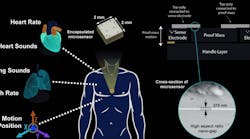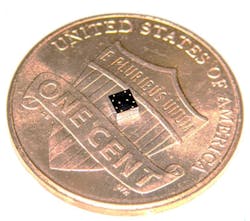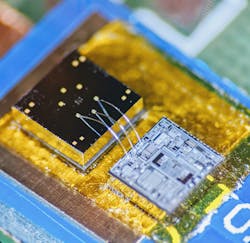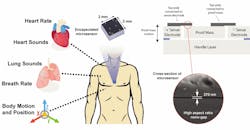A team of researchers at The Georgia Institute of Technology have designed and built a non-invasive sensor-in-a-chip about the size of a ladybug that records several different sounds from the heart and lungs, as well as body movements. Technicians can then analyze these sounds to get detailed information on the patient.
The chip acts as a high-tech electronic stetoscope combined with an accelerometer and is called an accelerometer contact microphone. It detects vibrations that enter from inside the body while filtering out distracting noises from outside the body’s core like airborne sounds.
“If it rubs on my skin or shirt, it doesn’t hear the friction, but the device is very sensitive to sounds coming at it from inside the body, so it picks up useful vibrations even through clothing,” says Farrokh Ayazi, a professor of electrical and computer engineering at Georgia Tech.
The chip’s sensing feature capability stems from two thin layers of silicon sandwiching a 270 nm gap, each carrying a small voltage. Vibrations from bodily motions and sounds send pressure waves through the chip which makes the voltage change subtly, but enough to create readable electronic outputs. The chip is also sealed inside a vacuum cavity to keep air currents form interfering with incoming vibrations. This reduces noise to an ultra-low level and gives the sensor an incredibly broad bandwidth, according to Ayazi.
Though the chip’s main engineering principle is simple, making it work and then manufacturable took a decade. The biggest challenge was the small gap. As Ayazi describes it, if the 2 × 2-mm chip were expanded to 100 × 100 yards, the air gap would be about an inch thick.
The researchers used a manufacturing process developed in Ayazi’s lab called the Harps+ platform (high aspect ratio poly and single crystalline silicon) for mass production. Turns out hand-sized sheets that are cut to the needed size. Harps+ is the first reported high-volume manufacturing process that delivers consistently thin gaps between two layers of silicon. It has been used to make many MEMS devices.
The current sensor is battery-powered and a second chip (called the signal-conditioning circuit) translates the sensor chip’s signals into patterned read-outs.
In human testing, the chip has recorded a variety of signals from the mechanical workings of the lungs and the heart with clarity—signals that often escape meaningful detection by current medical technology.
“Right now, doctors use EKGs (electrocardiograms) to get information on the heart, but they only measure electrical impulses,” says Ayazi. “But the heart is a mechanical system with muscles pumping and valves opening and shutting, and all those actions generate sounds an EKG does not detect. EKGs also say nothing about lung function.
The chip’s detection bandwidth is enormous from broad, sweeping motions to inaudibly high-pitched tones. Thus, the sensor chip simultaneously records details of the heartbeat, waves the heart sends through the body, and respiration rates and lung sounds. It even tracks the wearer’s physical activities, such as walking.
The signals are recorded in sync, potentially giving healthcare workers a detailed overview of a patient’s heart and lungs. For example, the researchers successfully recorded a “gallop,” a faint third sound after the more easily heard “lub-dub” of the heartbeat. Gallops are normally hard-to-detect clues of heart failure.
Medical research has tried for years to use the body’s mechanical signals, but recording some—such as sound moving through several different tissues—has proven inconsistent, while others—such as gallops—relied on years of clinician skills. The chip creates high-resolution, quantified data future research could match to pathologies and identify them.
The team plans to one day attach three sensors or more to a chest band to triangulate signals, determining exactly where they come from inside the body. So someday a similar device may pinpoint an emerging heart valve problem by the turbulence it generates in the bloodstream or pinpoint a cancerous lesion by faint crackling sounds in a lung.



